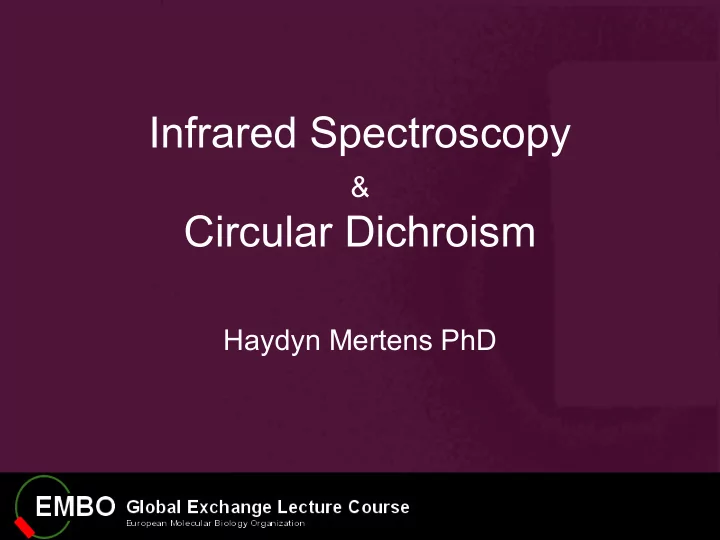

Infrared Spectroscopy & Circular Dichroism Haydyn Mertens PhD
Infrared Spectroscopy
Infrared Spectroscopy Electromagnetic spectrum: VIS med long-wave IR Short Gamma X-Ray UV IR microwaves radiowaves nm um mm m km Wavelength 10 -9 10 -6 10 -3 10 2 m 1 10 Functional groups absorb IR radiation Induced vibrational excitation
Vibrational modes Stretching of bonds (eg. water) Symmetric Asymmetric Bending 3 fundamental vibration modes
Vibrational modes Harmonic oscillator simple example eg. diatomic molecule Vibrational frequency: v ∝ k*m r eg. C=O, C=N (1500 - 1900 cm -1 ) C-H, N-H, O-H (2700 - 3800 cm -1 )
Units for IR spectroscopy Wavenumber number of wavelengths ( l ) per distance v = 1/ l (cm -1 ) proportional to frequency proportional to photon energy
Infrared (IR) Absorption: Proteins Barth & Zscherp, Quart. Rev. Biophys . 2002, 35(4), 369-430.
Infrared (IR) spectroscopy Traditional IR spectroscopy "dispersive" Monochromatic beam Measure absorbance Scan across different wavelengths FTIR Broadband used Excite multiple states/modes Adjust broadband and repeat Deconvolute spectrum
FTIR spectroscopy Key component is the interferometer http://www.chem.agilent.com Detected signal: Intensity as function of mirror position (cm) FT to obtain IR spectrum (cm -1 )
1D FTIR: Proteins Sensitive to secondary structure: Amide I and Amide II modes Ganim et al., Acc. Chem. Res., 2008, 41 (3), pp 432–441
1D FTIR: Proteins Sensitive to secondary structure: Amide I and Amide II modes Adapted from: Barth & Zscherp, Quart. Rev. Biophys., 2002, 35, pp 369-430
1D FTIR: Proteins Sensitive to secondary structure: Amide I and Amide II modes Adapted from: Barth & Zscherp, Quart. Rev. Biophys., 2002, 35, pp 369-430
1D FTIR: Proteins Limited information available. Lack of spatial information. Spectral congestion Ganim et al., Acc. Chem. Res., 2008, 41 (3), pp 432–441
2D-FTIR fs pulsed spectroscopy Frequency domain (pump-probe) Time domain (echo)
2D-FTIR fs pulsed spectroscopy Coupled systems See coherences
2D-FTIR Small molecule example: acetyl-acenato-rhodium dicarbonyl (RDC)
2D-FTIR: Proteins Ganim et al., Acc. Chem. Res., 2008, 41 (3), pp 432–441
Characteristic "shapes" Spectral patterns for secondary structure Ganim et al., Acc. Chem. Res., 2008, 41 (3), pp 432–441
Characteristic "shapes" Diagonally Z-shape Figure-8 elongated Ganim et al., Acc. Chem. Res., 2008, 41 (3), pp 432–441
Access to fast time-scale: 10 -13 s 10 -11 s 10 -9 s 10 -6 s 10 -3 s 10 4 s Secondary structure Domain folding Folding/Binding Short-range fluctuations formation (tertiary contacts) (aggregation) (side-chains, torsion-angles, hydrogen bonds)
Example: Protein Unfolding Thermal denaturation of Ubiquitin (Chung et al., PNAS. 2007, 104, 14237-14242.) 2D FTIR from MD simulation Experiment Folded Unfolded Difference Ganim et al., Acc. Chem. Res., 2008, 41 (3), pp 432–441
Amide I labeling 13 C- 16 O/ 18 O Specific labeling Shifts absorption band (red-shift) Reduces problem of spectral crowding
Example: Membrane Protein M2 (influenza A), H + gated ion channel Transmembrane helix conformation 13 C= 18 O labeled residues as probes Linewidth 13 C= 18 O increases with solvent contact Manor et al., Structure. 2009, 17, pp 247-254.
Summary FTIR Measure vibrational modes Identify secondary structure Monitor protein unfolding Investigate conformational change
Circular Dichroism
Circular Dichroism Absorbance spectroscopy of electronic transitions: A = e *c*l e = extinction coefficient (depends on wavelength, l ) c = concentration l = path length CD is difference between e for left and right circularly polarized light A L ( l ) - A R ( l ) = ∆A( l ) = [ e L ( l ) - e R ( l )]*l*c
Differential Absorption + e ∆ e - e L - e R Adapted from: Johnson, Ann. Rev. Biophys. Chem . 1988. 17: 145-66.
Amide Chromophores Protein backbone amides Electronic absorption (UV) Sensitive to orientation of transition dipoles amide n ---> pi * (210 nm) pi 1 ---> pi * (190 nm) Sensitive to backbone dihedral angles thus secondary structure
Amide Chromophores General scheme of electronic transitions 2p z n n
Amide Chromophores Transition dipoles n
Secondary Structure Absorption is modulated by Interactions between transitions: pi 1 ---> pi * coupling between peptide groups Mixing n ---> pi * and pi 1 ---> pi * within a peptide group Mixing n ---> pi * and pi 1 ---> pi * between peptide groups Influenced by geometry of peptide backbones --> Secondary structure!!!
Characteristic CD Spectra helix, sheet and "other" Myoglobin Concanavalin A + beta-lactoglobulin Type VI collagen ∆ -
The alpha-helix pi 1 ---> pi * + ∆ pi 1 ---> pi * - n ---> pi *
The beta-sheet + pi 1 ---> pi * ∆ n ---> pi * pi 1 ---> pi * -
"Other" (Random coil) + pi 1 ---> pi * ∆ - pi 1 ---> pi *
Circular Dichroism Differential ABS left and right polarised light www.jascoinc.com
Information content Using database of known structures Calculate amount of helix/sheet/other Secondary structure content Fold recognition More data (ie. VUV region) increases the information content
Example: Secondary structure content Voltage-gated sodium channel Minimal functional tetramer designed CD sprectrum (50 % helix) Melting curve (222 nm) 30% helix 19% helix McCusker et al., J. Biol. Chem. 2011, March 15 (epub)
Programs Contin-LL Selcon 3 CDSSTR VARSLC K2d Dichroweb server http://dichroweb.cryst.bbk.ac.uk
Recommend
More recommend